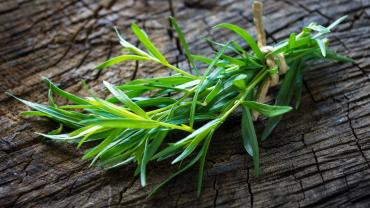
Tarragon: it’s a culinary herb that like cilantro has lovers and haters. For cilantro it’s the notorious “soapy” flavor that turns people off. With tarragon it’s the taste of licorice or anise and depending on your taste buds it’s either a selling point or a total turnoff. For those who enjoy the flavor tarragon joins the ranks of rosemary basil parsley and other herbs that not only add something special to recipes but also have beneficial effects for health.
The noted licorice flavor of tarragon comes from estragole—essential oil of French tarragon is 60-80% estragole and this compound is also found in anise fennel and not surprisingly to those who dislike it pine oil and turpentine! The distinct flavor and aroma make tarragon extract an ingredient in perfumes and cosmetics and tarragon vinegar which can be made easily at home adds an interesting touch to salads and vegetable dishes. Estragole is toxic to rats in large doses but experimental doses used to determine this have virtually no relevance to humans consuming tarragon as a culinary herb. (Russian tarragon has nearly no estragole and differs dramatically in taste and aroma from the French variety.)
Tarragon like most green herbs is loaded with nutrients although people generally don’t use herbs in large enough quantities for this to make much difference in terms of meeting their daily requirements for vitamins and minerals. (Anyone relying on things like dill and sage to check all their nutrient boxes for the day are “doing it wrong” as they say.) That being said every little bit helps and tarragon is high in vitamins C and B6 riboflavin folate manganese potassium magnesium calcium and iron.
Before we explore ways to include tarragon in home cooking (for those who like it that is) let’s see what some of the beneficial properties are.
Tarragon extract has some interesting effects on biochemical mechanisms at work in diabetes. Among these it reduces mRNA expression of phosphoenolpyruvate carboxykinase (PEPCK) the enzyme that catalyzes the first step in hepatic gluconeogenesis and which is often overexpressed in insulin-resistant individuals. (It was shown to reduce PEPCK mRNA expression by 28% in diabetic rats but had no significant effect in non-diabetic animals.) Tarragon extract also inhibits aldose reductase activity. “In cells excess glucose is converted to sorbitol by the aldose reductase enzyme which then accumulates in the cells causing a number of secondary diseases associated with the diabetic condition.” Additionally tarragon extract inhibits activity of tyrosine phosphatase-1B a key enzyme in the insulin signaling pathway. Mice lacking this enzyme have enhanced insulin sensitivity.
Extract from Russian tarragon has other potentially helpful effects for diabetes. It may enhance insulin secretion from cells and activate AMPK (AMP-activated protein kinase) an enzyme highly expressed in tissues with a large energy demand such as the skeletal muscle liver and brain. AMPK may influence mitochondrial biogenesis improve insulin sensitivity increase fatty acid oxidation reduce gluconeogenesis enhance glucose uptake and influence other aspects of glucoregulation and metabolic efficiency. Russian tarragon extract also has anti-inflammatory effects and may help preserve the life of β-cells.
Beyond its anti-hyperglycemic effects historically tarragon was employed as a pain reliever and aid for gastrointestinal discomfort. Modern science has corroborated these effects noting that tarragon extract demonstrates “peripheral and central antinociceptive activity” and this rationalizes “the traditional use of the plant in the treatment of different painful conditions.”
So how to use this herb in the kitchen? The French employ it in chicken recipes and egg dishes. Consider tarragon mustard chicken (with shredded coconut for breading) or tarragon chicken with spinach. Tarragon also pairs well with fish such as in lemon tarragon salmon pan-seared tarragon whitefish or broiled shrimp cocktail with tarragon sauce from the experts at America’s Test Kitchen who have a Paleo cookbook out full of tried-and-true recipes. Tarragon is great with omelets and quiches and it’s a nice touch in these crab-stuffed deviled eggs with tarragon.